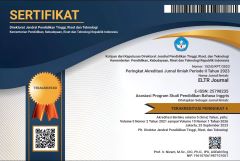AN ANALYSIS OF STUDENTS’ SPEAKING ANXIETY IN ACADEMIC SPEAKING CLASS
Abstrak terlihat: 23576 / PDF terunduh: 17235DOI:
https://doi.org/10.37147/eltr.v4i2.70Keywords:
anxiety, speaking english, academic speaking classAbstract
The study aimed to gain information about what made students felt anxious and what factors triggered students’ speaking anxiety in Academic Speaking class in English Language Education Program (ELEP) in a private university in Central Java, Indonesia. The participants of the study were 52 second-year ELEP students. A close-ended and open-ended questionnaire developed from Horwitz et al, (1986) and Angelia and Listyani (2019) were administered to the participants. The findings revealed that students’ speaking anxiety in English speaking class was derived from three main factors of anxiety, i.e. communication apprehension, test anxiety and fear of negative evaluation. Moreover, as the questionnaires answers and interview data revealed, lack of vocabulary, underestimate their ability, lack of preparation, being afraid of making mistakes, and worried of being embarassed at by his/her friends had also contributed to students’ anxiety in speaking. These findings suggest that the teachers’ role is very important in this situation. Students and teachers could build a positive classroom atmosphere in order to overcome students’ anxiety.
Downloads
References
Agbalizu, M. U. (2006). How does anxiety affect performance in a foreign language?. The Institute of Education. The British University. A thesis. Retrieved from https://pdfs.semanticscholar.org/a534/553276286e3c64d5c96e5f98cda1e8093981.pdf
Angelia & Listyani. (2019). Freshmen’s anxiety in an intensive listening class: A qualitative study. Educational Research and Reviews, 14(12), 443-457. doi: https://doi.org/10.5897/ERR2018.3624
Bailey, P., Daley, C. E., & Onwuegbuzie, A. J. (1999). Foreign language anxiety and learning style. Foreign Language Annals, 32(1), 63–76. doi:10.1111/j.1944-9720.1999.tb02376.x
Christie, L. S., & Listyani. (2018). Teachers’ strategies to improve students’ self-confidence in speaking. Register Journal, 11(2), 139-153. Retrieved from: https://www.academia.edu/37893732/Teachers_Strategies_to_Improve_Students_Self-Confidence_in_Speaking
Dawood, E., Hind Al Ghadeer, R. M., Almutary, N., & Alenezi, B. (2016). Relationship between test anxiety and academic achievement among undergraduate nursing students. Journal of Education and Practice, 7(2), 57-65. Retrieved from: https://files.eric.ed.gov/fulltext/EJ1089777.pdf
Dislen, G. (2013). The reason of lack of motivation from the students’ and teachers’ voice. The Journal of Academic Social Science, 35-45. Retrieved from: https://www.researchgate.net/publication/308792361_THE_REASONS_OF_LACK_OF_MOTIVATION_FROM_THE_STUDENTS'_AND_TEACHERS'_VOICES
Dornyei, Z. (2003). Questionnaires in second language research: construction, administration, and processing. Mahwah, New Jersey: Lawrence Erlbaum Associates, Publishers. Retrieved from: http://www.drronmartinez.com/uploads/4/4/8/2/44820161/dornyei_questionnaires_2003.pdf
Easwaramoorthy, M., & Zarinpoush, F. (2006). Interviewing for research. Toronto: Imagine Canada. Retrieved from: http://sectorsource.ca/sites/default/files/resources/files/tipsheet6_interviewing_for_research_en_0.pdf
Guion, L. A., Diehl, D. C., & McDonald, a. D. (2001). Conducting an in-depth interview. Academic Press.
Horwitz, E. K., Horwitz, M. B., & Cope, J. (1986). Foreign language classroom anxiety. The Modern Language Journal, 70(2), 125–132. doi:10.1111/j.1540-4781.1986.tb05256.x
Hyman, M. R., & Sierra, J. J. (2016). Open- versus closed-ended survey questions. Business Outlook, 14(2), 1-5. Retrieved from: https://www.academia.edu/16266400/Open-_versus_close-ended_survey_questions
Indrianty, S. (2016). Students' anxiety in speaking English (a case study in one hotel and tourism college in Bandung). ELTIN Journal, 28-40. Retrieved from: http://e-journal.stkipsiliwangi.ac.id/index.php/eltin/article/viewFile/337/258
Irsyad, R. F., & Narius, D. (2013). Teaching speaking through retelling stories of cartoon movies at junior high school. Journal of English Language Teaching, 2 (1), 295-301. Retrieved from: http://ejournal.unp.ac.id/index.php/jelt/article/viewFile/2617/2217
Kleinmann, H. H. (1977). Avoidance behavior in adult second language acquisition. Language Learning, 27(1), 93–107. doi:10.1111/j.1467-1770.1977.tb00294.x
Krashen, S.D. (1983). The Input Hypothesis: Issues and implications. New York: Longman. Retrieved from: https://www.uio.no/studier/emner/hf/iln/LING4140/h08/The%20Input%20Hypothesis.pdf
Liu, M. (2007). Anxiety in Oral English Classroom: A Case Study in China. Indonesian Journal of English of English Language Teaching, 3 (1), 119-137. Retrieved from: http://ojs.atmajaya.ac.id/index.php/ijelt/article/view/132/89
Marcos-Llinás, M., & Garau, M. J. (2009). Effects of language anxiety on three proficiency-level courses of Spanish as a foreign language. Foreign Language Annals, 42(1), 94-111. Retrieved from: http://www.academypublication.com/issues/past/tpls/vol04/05/09.pdf
MacIntyre, P. D., & Gardner, R. C. (1991). Investigating language class anxiety using the focused essay technique. The Modern Language Journal, 75(3), 296–304. doi:10.1111/j.1540-4781.1991.tb05358.x
MacIntyre, P. D., & Gardner, R. C. (1991). Methods and results in the study of anxiety and language learning: A review of the literature. Language Learning, 41(1), 85–117. doi:10.1111/j.1467-1770.1991.tb00677.x
Na, Z. (2007). A study of high school students' English learning anxiety. The Asian EFL Journal, 9(3), 22-34. Retrieved from: https://www.asian-efl-journal.com/main-journals/a-study-of-high-school-students-english-learning-anxiety/
Occhipinti, A. (2009). Foreign language anxiety in in-class speaking activities. The Department of Literature, Area Studies, and European Language. The University of Oslo. A thesis. Retrieved from https://www.duo.uio.no/handle/10852/25584
Permatasari, D. (2015). Students’ Anxiety in English Speaking Class (A Qualitative Study at SMA Negeri 3 Banda Aceh). Universitas Syiah Kuala. A thesis. Retrieved from https://etd.unsyiah.ac.id/baca/index.php?id=19547&page=1
Sari, D. (2017). Speaking anxiety as a factor in studying EFL. EEJ (English Education Journal), 8(2), 177-186. Retrieved from: http://jurnal.unsyiah.ac.id/EEJ/article/view/7226/5938
Singh, M. K. M. (2013). Academic speaking practices of international graduate students in a higher education institution in Malaysia: Challenges and overcoming strategies. International Journal of Education and Research, 1(7), 1-14 Retrieved from https://ijern.com/journal/July-2013/21.pdf
Souriyavongsa, T., Rany, S., Abidin, M. J., & Mei, L. L. (2013). Factors cause students low English language learning: A Case Study in the National University of Laos. International Journal of English Language Education, 1(1), 179-192. Retrieved from: http://iosrjournals.org/iosr-jhss/papers/Vol.%2024%20Issue4/Series-10/G2404103942.pdf
Speilberger, C, D. (1983). Anxiety. New York: Academic Press
Steinberg, F. S., & Horwitz, E. K. (1986). The effect of induced anxiety on the denotative and interpretive content of second language speech. TESOL Quarterly, 20, 131– 136. doi: https://doi.org/10.2307/3586395
Watson, D., & Friend, R. (1969). Measurement of social-evaluate anxiety. Journal of Consulting and Clinical Psychology, 33(4), 448-57. doi: 10.1037/h0027806
Queiros, A., Faria, D., & Almeida, F. (2017). Strength and limitations of qualitative and quantitative research methods. European Journal and Educational Studies, 3(9), 369-387. doi: 10.5281/zenodo.887089
Downloads
Published
How to Cite
Issue
Section
License
Copyright (c) 2020 Maria Eva Damayanti, Listyani Listyani

This work is licensed under a Creative Commons Attribution-ShareAlike 4.0 International License.













